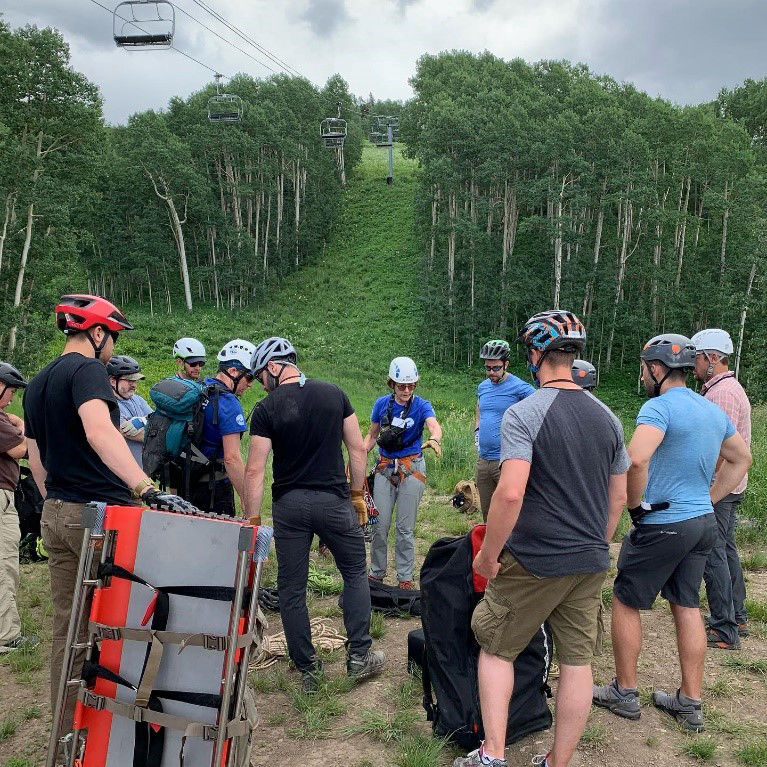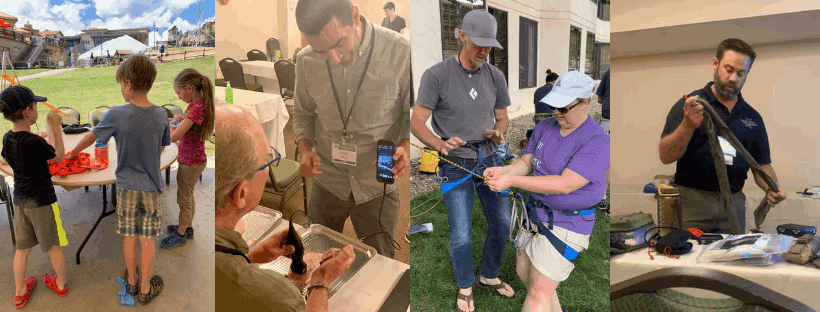On Monday afternoon, I finally found the time to get up on the mountain. I put on my hiking shoes and headed up the Lower Westside trail to capture some footage of the Intro to Search and Rescue workshop with Martin Musi and Alison Sheets. If you don’t know these two instructors, take my advice and sign up for a session with them in the future. Their workshop was fantastic. After learning basic knowledge and skills, the group simulated an actual search and rescue operation, from the initial radio call-in all the way through treatment and evacuation of the patient. The session received some of the highest marks I have ever seen on an evaluation and attendees raved about the engaging and effective teaching methods.

Despite the temptation to hike, bike or partake in other recreational activities in the breathtaking area, many afternoon small group sessions were packed and workshops sold out fast. It was clear that conference attendees came seeking to get as much out of the conference as possible and hands-on sessions with high faculty to student ratios are incredibly valuable. I wish I could go in-depth on each and every one of them, primarily because the instructors are so passionate about what they’re teaching; however, here are some highlights from just a few:
- Wilderness Medicine for Kids: This was something new for the WMS and it was really neat seeing members share their passion for wilderness medicine with their young children. The kids, much to my surprise, were engaged the entire three hours and walked away with a significant amount of lessons learned. One attendee shared that the session was “phenomenal” and that they thought, “the instructors were great, including the kids. It was so well thought out and all encompassing. It was great to prompt critical thinking and introduce new knowledge/skills at an age-appropriate level. Kudos for thinking outside the box with this one.” Hopefully this will be one that continues to grow!
- Wilderness Ultrasound: One of the first to sell out, point-of-care ultrasound is certainly a hot topic right now. I knew it was going to be interesting when speaker Daniel Ackil told us at registration that he was sneaking away to go buy raw chicken breasts for the session. Participants were able to practice localizing a nerve and also take turns being the “patient” as others gained general experience with the technology. We had lots of requests for a repeat of this session and it’s a need we hope to meet in the future.
- Escaping the Belay: Philip Johnson and David Weber especially nailed the combination of education and application in a fun and engaging way in this workshop. Every time I poked my head in, attendees seemed to have smiles on their faces, be hanging on their every word, or busy practicing the various skills.
- Operational Med Kits, A Special Operations Forces Perspective: Standing room only for this one! I heard several people talking about how Ryan Christensen demonstrated how to control massive hemorrhage using an improvised junctional tourniquet with a Nalgene bottle, triangular cravat bandage, two rappel rings and an aluminum tent pole splint as a windlass. Many attendees stayed after to take a closer look at the supplies Ryan had brought which were spread out across multiple tables.

This year we added a few social events to the schedule which were all very well-received: a Meet the Board of Directors Happy Hour as well as a Run, Walk or Hike with the Board, and an Adventure CME Info Session where those interested in a future trip could meet other potential participants and get their questions answered.
At Tuesday evening’s Awards Banquet, past-president Aaron Billin recognized members with extraordinary dedication to and accomplishments within the field of wilderness medicine and the Society. Click here to learn more about all the recipients.
2018-2019 Board President Bob Quinn then presented Scott McIntosh with the president’s green jacket, which he joked is clearly the “envy of every style.” We are grateful for Bob’s service and look forward to a year of leadership under Scott. Opposed to the traditional “passing of the gavel,” the two started a new tradition of passing the ice axe, which seems much more fitting for our organization.
Before the keynote, Jenn Dow took a few minutes to honor Jen Kurmaskie-Konopka, a faculty member who tragically lost her battle with cancer just a few weeks prior to the conference. Her husband Rich was present to accept an honorary FAWM medal on her behalf. It was a beautiful tribute and Jen will be deeply missed by the WMS community.
I couldn’t complete this conference recap without telling you about the incredibly impactful keynote presentation by Quinn Brett. Quinn began by sharing a long list of impressive climbing accomplishments. She lived a life of adventure and found her joy in the outdoors and being active until a day in October of 2017 when her mind was distracted and she made a mistake that would forever change her life. After a 100-foot fall from El Cap in Yosemite, some of the very people she had worked with to save lives were now focused on saving hers. Quinn suffered significant injuries, the most significant being a severe spinal cord injury that left her paralyzed from the waist down.
Quinn shared the stage briefly with Philip Johnson, who was incident commander of her rescue and they both shared their recollection of that day and how it has impacted them. The bond they shared was like no other. They were incredibly strong yet vulnerable all at the same time.